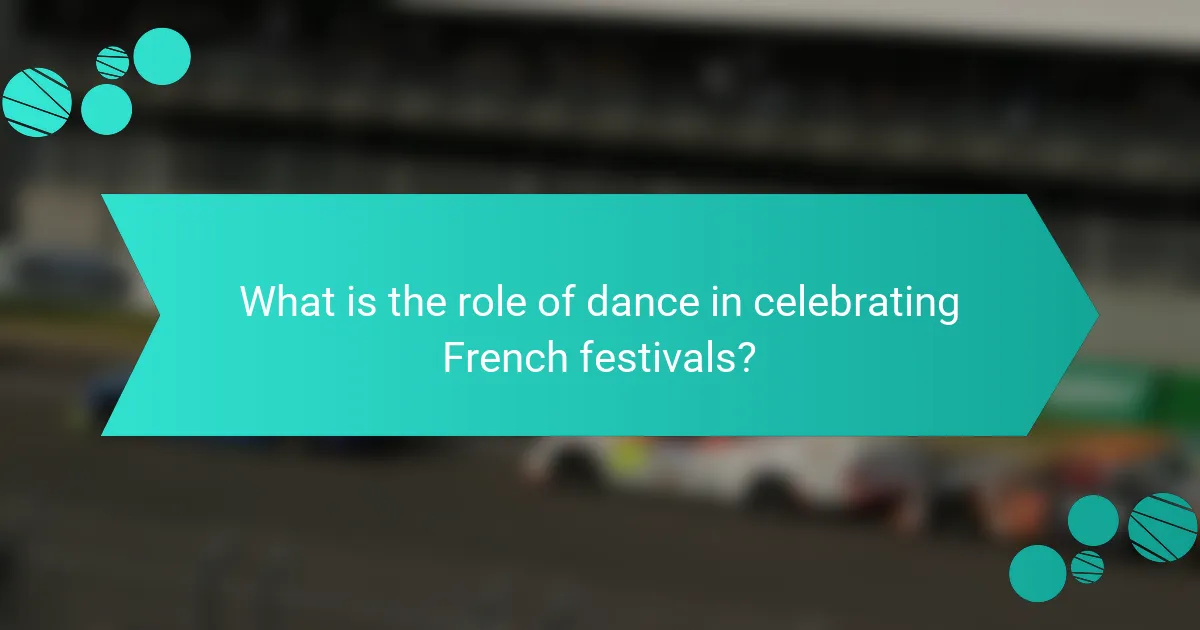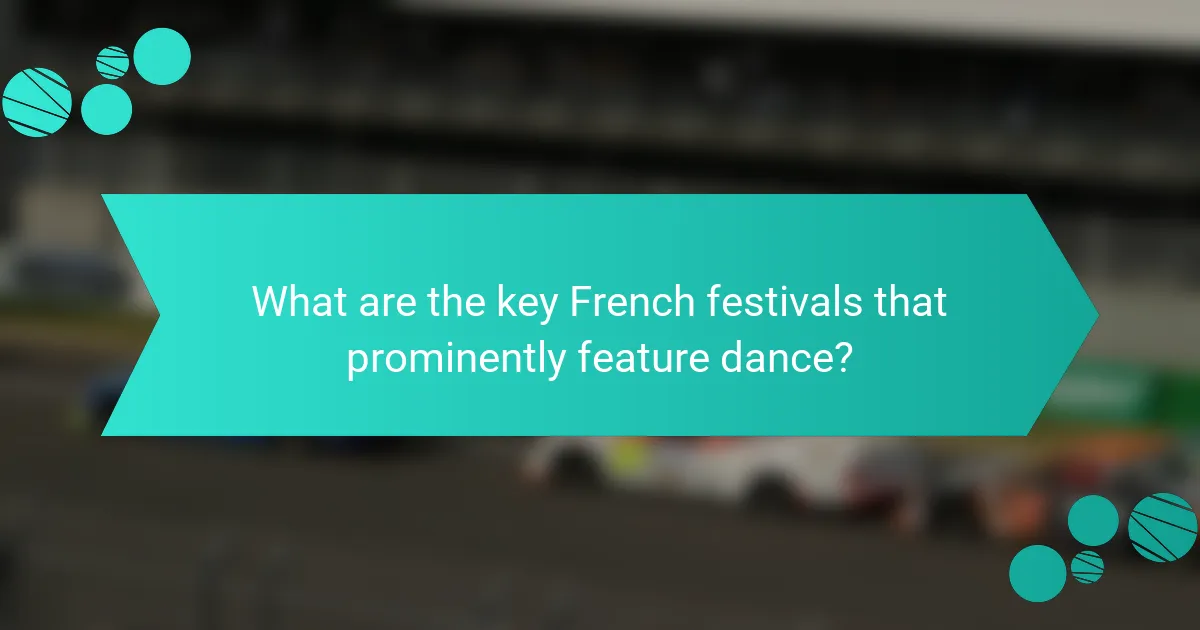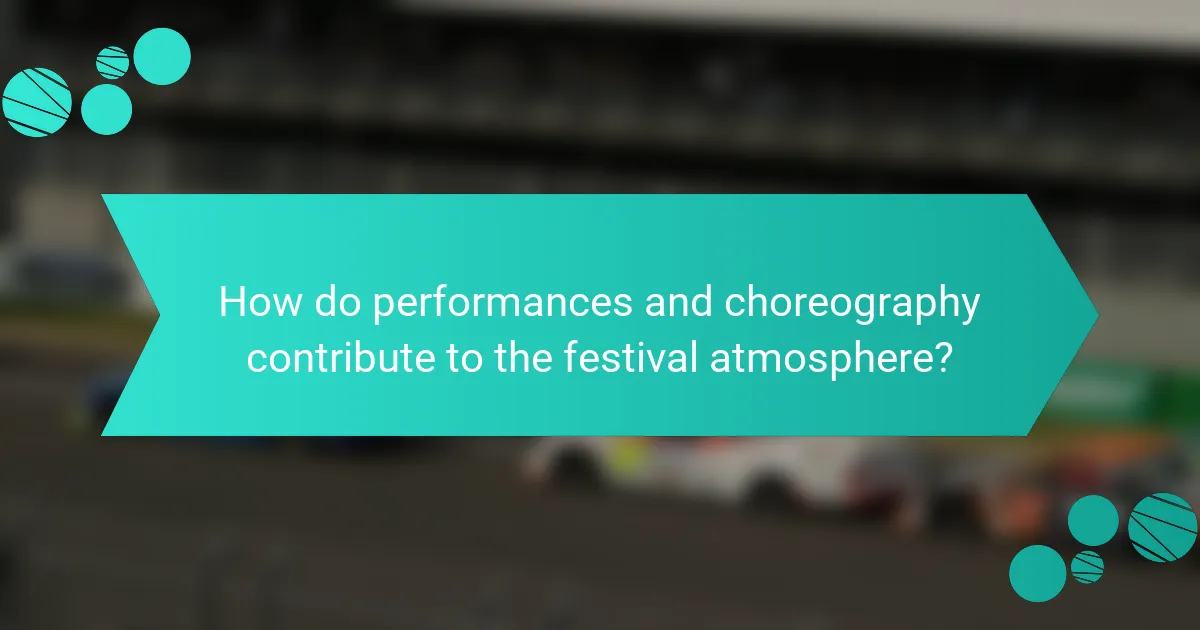Dance is a vital component of French festivals, serving as a medium for cultural expression and community bonding. Key festivals such as Bastille Day, the Festival d’Avignon, the Carnival of Nice, and the Fête de la Musique prominently feature dance performances that reflect local traditions and national pride. Traditional dances, including the bourrée, are integral to folk festivals, preserving historical customs and enhancing the celebratory atmosphere. Through dynamic choreography and engaging performances, dance fosters social interaction and unity among participants, contributing to the vibrancy and enjoyment of these cultural events. The impact of dance on festival attendance and audience engagement underscores its significance in celebrating French heritage.

What is the role of dance in celebrating French festivals?
Dance plays a significant role in celebrating French festivals. It serves as a medium for cultural expression and community bonding. Various regional dances showcase local traditions and heritage. Festivals like Bastille Day feature lively dances that reflect national pride. Dances often accompany music and theatrical performances, enhancing the celebratory atmosphere. Traditional dances, such as the bourrée, are performed during folk festivals, preserving historical customs. In addition, dance fosters social interaction among participants, creating a sense of unity. Overall, dance is integral to the vibrancy and enjoyment of French festivals.
How does dance enhance the experience of French festivals?
Dance enhances the experience of French festivals by fostering community engagement and cultural expression. It serves as a medium for storytelling, reflecting the history and traditions of the region. Dance performances attract audiences, creating a festive atmosphere that encourages participation. Events like the Fête de la Musique showcase various dance styles, highlighting regional diversity. Moreover, dance workshops during festivals allow attendees to learn and connect with local customs. The rhythmic movements of dance promote joy and celebration, enhancing the overall festival experience. Historical records indicate that dance has been integral to French culture for centuries, reinforcing its significance in contemporary festivities.
What types of dances are commonly performed during these festivals?
Common types of dances performed during French festivals include traditional folk dances, contemporary dance, and regional specialties. Traditional folk dances, such as the bourrée and the farandole, are often showcased. Contemporary dance performances may also be featured, reflecting modern artistic expressions. Regional specialties highlight local culture, such as Breton dances in Brittany or Provençal dances in Provence. These dances are integral to the celebrations, fostering community spirit and cultural identity. Festivals often include competitions and performances that attract both locals and tourists.
How do cultural influences shape the dance styles at French festivals?
Cultural influences significantly shape the dance styles at French festivals. Various regions in France showcase distinct dance forms influenced by local traditions. For example, Breton dances reflect Celtic heritage, featuring lively steps and community participation. In contrast, the Alsatian region incorporates elements of German folk dances, characterized by polkas and waltzes. Historical migrations and cultural exchanges have introduced diverse styles, such as African and Caribbean influences in urban festivals. Festivals often celebrate these cultural blends, allowing for dynamic performances that evolve over time. The integration of traditional music further enhances the authenticity of these dance styles. Overall, cultural diversity enriches the dance landscape at French festivals, creating a vibrant celebration of heritage.
Why is dance considered a vital tradition in French celebrations?
Dance is considered a vital tradition in French celebrations due to its historical and cultural significance. It serves as a means of expression during festive events. Traditional dances often reflect regional identities and heritage. Various festivals, such as Bastille Day, prominently feature dance. These performances foster community spirit and unity among participants. Dance also enhances the celebratory atmosphere, making events more vibrant. Historical records indicate that dance has been part of French culture for centuries. This deep-rooted tradition continues to evolve while maintaining its importance in modern celebrations.
What historical significance does dance hold in French festivals?
Dance has historical significance in French festivals as a means of cultural expression and community bonding. It has roots in ancient traditions, often linked to agricultural cycles and religious ceremonies. Over centuries, dance evolved to reflect regional identities and social changes in France. Traditional dances, such as the Breton gavotte and the Occitan farandole, showcase local heritage. Festivals like Bastille Day and Carnaval de Nice prominently feature dance as a celebration of national pride and unity. Historical records indicate that dance was integral to festivities as early as the Middle Ages, serving both entertainment and ritualistic purposes. Thus, dance remains a vital component of France’s cultural landscape, symbolizing continuity and collective memory.
How do dance performances reflect the values and beliefs of French culture?
Dance performances reflect the values and beliefs of French culture through their expression of history, social norms, and artistic traditions. Traditional dances often depict historical events or folklore, showcasing France’s rich heritage. For instance, the Can-Can originated in the 19th century and symbolizes the spirit of freedom and rebellion. Dance also serves as a medium for social commentary, reflecting contemporary issues and values, such as equality and community. Festivals like Bastille Day feature traditional dances that celebrate national pride and unity. Additionally, the importance of elegance and artistry in French ballet highlights the cultural emphasis on aesthetics and refinement. Overall, dance performances encapsulate the essence of French identity, bridging past and present cultural narratives.

What are the key French festivals that prominently feature dance?
Key French festivals that prominently feature dance include the Festival d’Avignon, the Carnival of Nice, and the Fête de la Musique. The Festival d’Avignon is known for its theatrical performances, including various dance shows. The Carnival of Nice showcases vibrant parades with dance performances as a central highlight. The Fête de la Musique celebrates music and dance across France, encouraging public participation in performances. These festivals reflect the rich cultural heritage of dance in France.
Which festivals are known for their unique dance traditions?
Bastille Day is known for its unique dance traditions, especially the traditional French cancan. This festival occurs annually on July 14th. The cancan is characterized by high-energy choreography and lively music. Another festival is the Festival of Avignon, which features various contemporary dance performances. This festival takes place in July and showcases innovative dance styles. The Fête de la Musique also includes dance elements, celebrating music and dance on June 21st. Each of these festivals highlights the cultural significance of dance in French heritage.
What are the specific dances associated with each major festival?
Bastille Day features the Can-Can dance, symbolizing French culture and revolution. The Fête de la Musique showcases various dances, including traditional folk dances like the Bourrée. The Carnival of Nice features the lively dance of the Mimo, representing the festive spirit of the event. The Festival of Avignon includes theatrical dances that highlight contemporary and classical themes. Each festival incorporates dances that reflect its unique cultural significance and history. These dances contribute to the overall celebration and enjoyment of the festivals.
How do regional variations impact dance styles at these festivals?
Regional variations significantly influence dance styles at French festivals. Different regions in France have unique cultural histories and traditions. These factors shape the music, costumes, and movements associated with their dances. For example, Brittany is known for its traditional folk dances like the Gavotte. In contrast, the south of France features lively dances such as the Farandole.
The geographic landscape also plays a role. Coastal areas may have maritime influences in their dance styles. Inland regions might incorporate agricultural themes. Regional festivals often showcase these distinct styles, highlighting local identity. This diversity enriches the overall festival experience. Each dance tells a story reflective of its region’s heritage and customs.
What role do community and participation play in festival dances?
Community and participation are essential in festival dances as they foster social cohesion and cultural identity. These dances often involve collective efforts from local participants, reinforcing bonds among community members. Active participation allows individuals to express their cultural heritage and traditions. It also enhances the overall experience of the festival, making it more vibrant and engaging. Historical evidence shows that festivals with strong community involvement attract larger audiences and promote local pride. For instance, festivals like La Fête de la Musique in France highlight community collaboration through music and dance, showcasing the importance of participation.
How do local communities engage in dance during festivals?
Local communities engage in dance during festivals through organized performances and traditional group dances. These dances often reflect local culture and history. Community members participate by learning and practicing specific dance styles. Festivals provide a platform for showcasing these dances to attendees. Many festivals feature competitions that encourage participation and skill development. Dancers often wear traditional costumes, enhancing the cultural experience. Local music accompanies the dances, creating an immersive atmosphere. This engagement fosters community spirit and preserves cultural heritage.
What opportunities exist for visitors to participate in these dances?
Visitors can participate in dances at French festivals through workshops and community events. Many festivals offer dance classes led by local instructors. These classes cater to various skill levels, making them accessible to all. Additionally, some festivals feature open dance floors where attendees can join in. Traditional dances often invite audience participation during performances. Cultural organizations may host special events for visitors to learn and engage. Local dance troupes sometimes perform and encourage audience involvement. This creates an immersive experience for visitors. Overall, these opportunities foster cultural exchange and celebration.

How do performances and choreography contribute to the festival atmosphere?
Performances and choreography enhance the festival atmosphere by creating a vibrant and engaging environment. They draw attendees’ attention and foster a sense of community. Dynamic movements and coordinated routines captivate audiences, encouraging participation. This interaction elevates the overall energy of the event. Performances often reflect cultural heritage, enriching the festival’s significance. Choreography can convey stories and emotions, deepening the audience’s connection. The visual spectacle of dance adds to the festive ambiance, making it memorable. Festivals featuring dance often report increased attendance, showcasing its impact on engagement.
What are the elements of choreography that enhance dance performances at festivals?
The elements of choreography that enhance dance performances at festivals include formation, timing, and expression. Formation refers to the arrangement of dancers on stage, which can create visual interest. Effective timing ensures synchronization with music and enhances the overall rhythm. Expression involves the emotional portrayal of the performance, connecting with the audience. Additionally, transitions between movements can create fluidity and maintain engagement. The use of props and costumes can also elevate the visual appeal. Research indicates that well-structured choreography increases audience enjoyment and participation at cultural events.
How do lighting and costumes influence the overall impact of dance performances?
Lighting and costumes significantly influence the overall impact of dance performances. Lighting enhances mood and atmosphere, guiding audience perception. For instance, bright lights can evoke energy, while dim lighting can create intimacy. Costumes contribute to character portrayal and visual storytelling. They can reflect cultural heritage, as seen in traditional French dance attire. Together, lighting and costumes shape the audience’s emotional response. Research shows that effective lighting can increase engagement by up to 30%. This synergy creates a more immersive experience, highlighting the artistry in dance performances.
What are some notable dance performances that have become iconic at French festivals?
Notable dance performances that have become iconic at French festivals include the “Can-Can” at the Moulin Rouge and the “Ballet de l’Opéra de Paris” at the Paris Opera. The Can-Can is a high-energy dance characterized by its lively music and high kicks. It gained fame in the 19th century and is now a symbol of French cabaret culture. The Ballet de l’Opéra de Paris showcases classical ballet and is renowned for its artistic excellence. This ballet company has a long history, dating back to 1669, making it one of the oldest in the world. Another iconic performance is the “Fête de la Musique,” which features various dance genres throughout France. This festival celebrates music and dance annually on June 21. These performances reflect the rich cultural heritage of France and its dedication to the arts.
How do these performances showcase the diversity of French dance?
French dance performances showcase diversity through a variety of styles and cultural influences. They incorporate traditional forms like ballet, which originated in the French court, and modern styles such as hip-hop and contemporary dance. Regional dances, like Breton folk dance, highlight local traditions and customs. Dance festivals in France often feature international artists, promoting cross-cultural exchange. This blend of styles reflects the multicultural nature of French society. Events such as the Festival d’Avignon celebrate this variety by bringing together diverse dance companies. The range of performances illustrates the evolution of dance in France, making it a vibrant art form.
What stories or themes are commonly portrayed through these performances?
Common themes portrayed through dance performances in French festivals include cultural heritage, community celebration, and historical narratives. These performances often depict stories of local traditions and folklore. They celebrate significant events and milestones in French history. Dances may also symbolize seasonal changes and agricultural cycles. Additionally, themes of love, unity, and social cohesion are frequently highlighted. Many performances showcase the diversity of regional customs and styles. Overall, dance serves as a vibrant medium for expressing collective identity and shared values within French culture.
What tips can help enhance the experience of attending dance performances at French festivals?
Arriving early to secure a good viewing spot enhances the experience of attending dance performances at French festivals. This allows for a better perspective of the dancers and the choreography. Engaging with local culture through pre-show activities can also enrich the experience. Many festivals offer workshops or discussions that provide context to the performances. Dressing comfortably is crucial, as festivals often involve standing or sitting for long periods. Staying hydrated and bringing snacks can keep energy levels up throughout the event. Familiarizing oneself with the festival schedule helps in planning which performances to attend. Lastly, connecting with fellow attendees can create a shared experience, enhancing enjoyment.
The main entity of this article is the role of dance in celebrating French festivals. The article explores how dance serves as a vital medium for cultural expression, community bonding, and storytelling during various festivals in France, such as Bastille Day and the Fête de la Musique. It discusses the types of dances performed, their historical significance, and the impact of regional variations on dance styles. Additionally, the article highlights the importance of community participation and the opportunities available for visitors to engage in these dance traditions, while also examining how performances and choreography enhance the festival atmosphere.